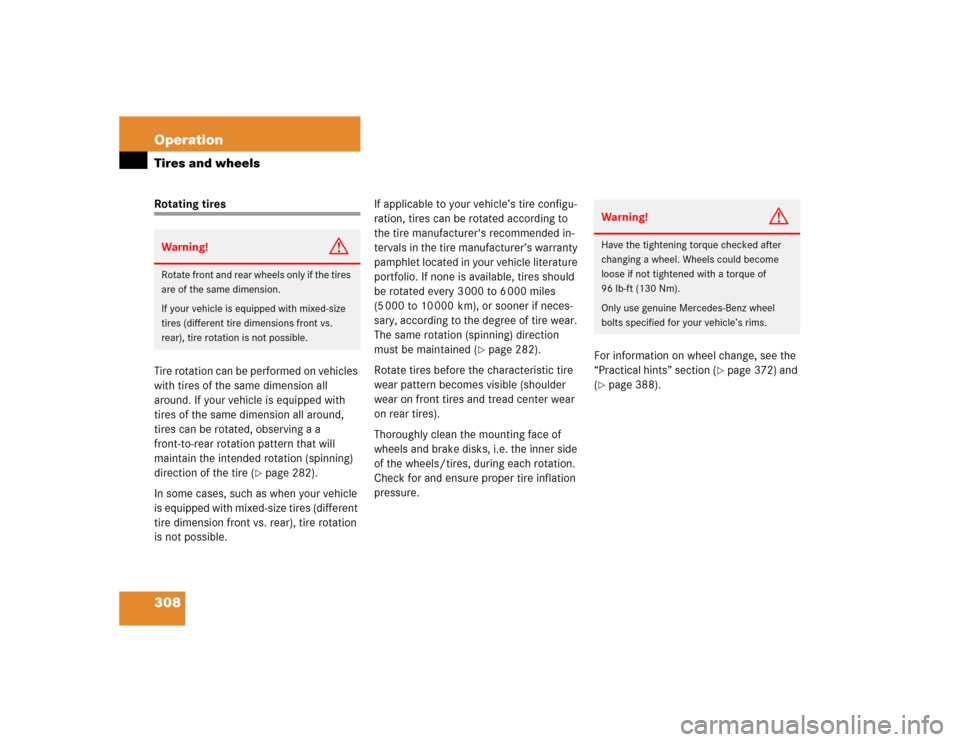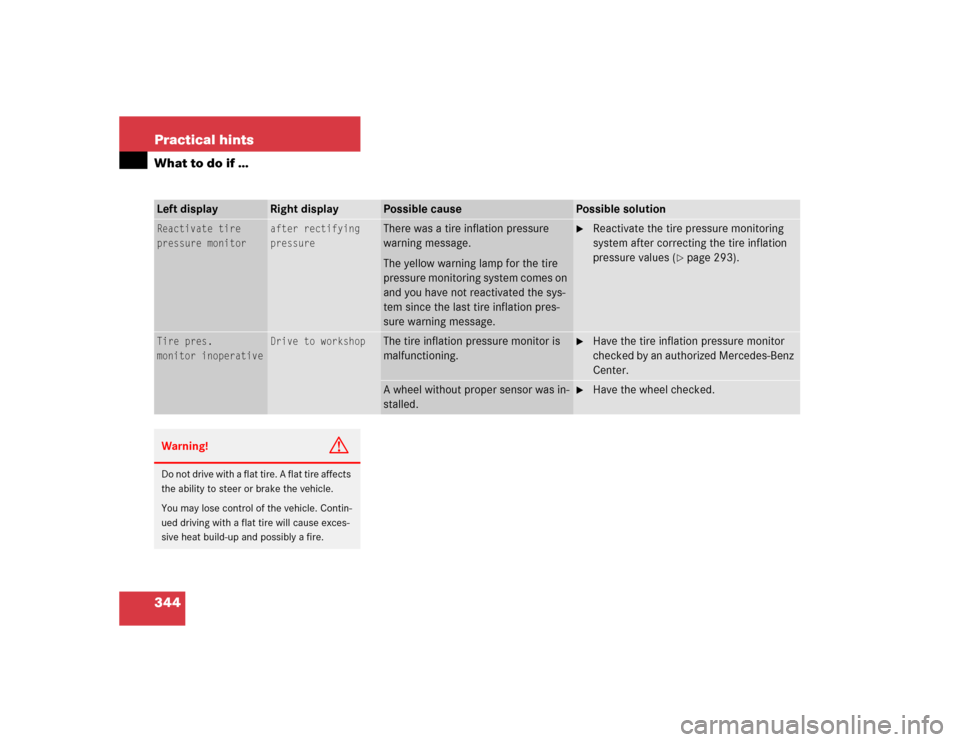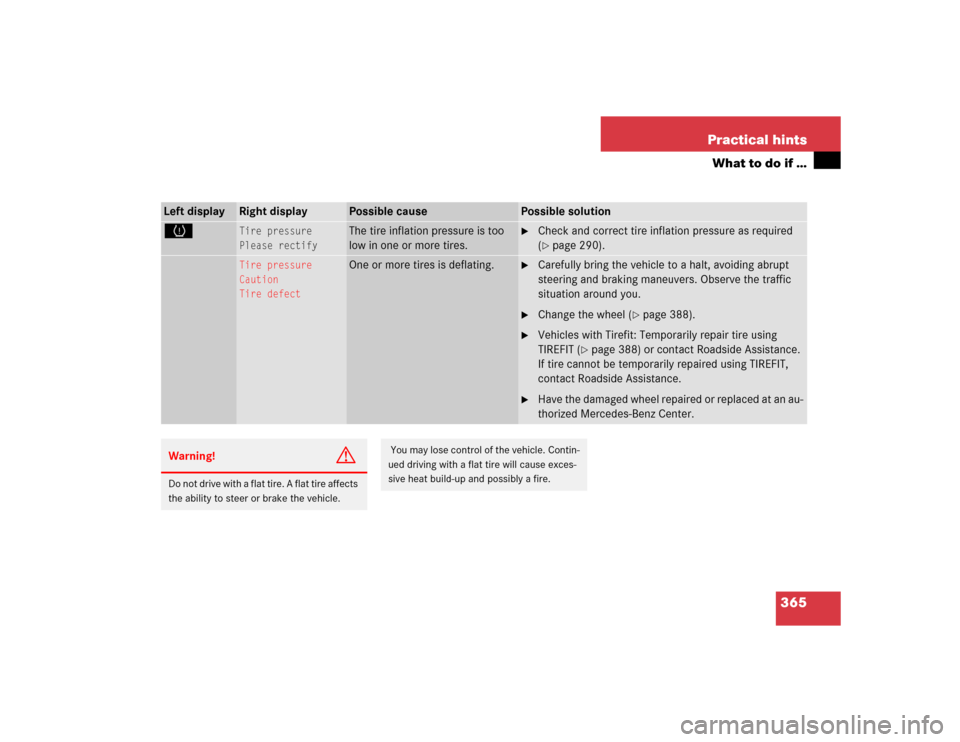Page 310 of 474

308 OperationTires and wheelsRotating tires
Tire rotation can be performed on vehicles
with tires of the same dimension all
around. If your vehicle is equipped with
tires of the same dimension all around,
tires can be rotated, observing a a
front-to-rear rotation pattern that will
maintain the intended rotation (spinning)
direction of the tire (
�page 282).
In some cases, such as when your vehicle
is equipped with mixed-size tires (different
tire dimension front vs. rear), tire rotation
is not possible.If applicable to your vehicle’s tire configu-
ration, tires can be rotated according to
the tire manufacturer's recommended in-
tervals in the tire manufacturer’s warranty
pamphlet located in your vehicle literature
portfolio. If none is available, tires should
be rotated every 3 000 to 6 000 miles
(5 000 to 10 000 km), or sooner if neces-
sary, according to the degree of tire wear.
The same rotation (spinning) direction
must be maintained (
�page 282).
Rotate tires before the characteristic tire
wear pattern becomes visible (shoulder
wear on front tires and tread center wear
on rear tires).
Thoroughly clean the mounting face of
wheels and brake disks, i.e. the inner side
of the wheels/tires, during each rotation.
Check for and ensure proper tire inflation
pressure.For information on wheel change, see the
“Practical hints” section (
�page 372) and
(
�page 388).
Warning!
G
Rotate front and rear wheels only if the tires
are of the same dimension.
If your vehicle is equipped with mixed-size
tires (different tire dimensions front vs.
rear), tire rotation is not possible.
Warning!
G
Have the tightening torque checked after
changing a wheel. Wheels could become
loose if not tightened with a torque of
96 lb-ft (130 Nm).
Only use genuine Mercedes-Benz wheel
bolts specified for your vehicle’s rims.
Page 325 of 474
323 Practical hints
What to do if …
Where will I find ...?
Locking/unlocking in an emergency
Replacing bulbs
Replacing wiper blades
Flat tire
Batteries
Jump starting
Towing the vehicle
Fuses
Page 335 of 474

333 Practical hints
What to do if …
Problem
Possible cause
Suggested solution
H
The yellow warning lamp for the
tire pressure monitoring system
comes on.
The tire pressure monitoring system de-
tects a loss of pressure in at least one tire.
�
Bring the vehicle to a halt, avoiding
abrupt steering and braking maneuvers.
Observe the traffic situation around you.
�
Take note of the messages in the multi-
function display.
The warning lamp goes out once the tire in-
flation pressure monitor has been reactivat-
ed after the tire inflation pressure has been
corrected.
Warning!
G
When the tire pressure monitoring system
warning light is lit, one or more of your tires
is significantly under-inflated. You should
stop and check your tires as soon as possi-
ble, and inflate them to the proper pressure
as indicated on the vehicle’s tire information
placard. Driving on a significantly under-in-
flated tire causes the tire to overheat and
can lead to tire failure.
Under-inflation also reduces fuel efficiency
and tire tread life, and may affect the vehi-
cle’s handling and stopping ability. Each tire,
including the spare, should be checked
monthly when cold and set to the recom-
mended inflation pressure as specified in
the vehicle placard and owner’s manual.
iThe recommended tire inflation pres-
sures for your vehicle can be found on
the tire placard on the driver’s door
B-pillar, not in the owner’s manual.
Page 345 of 474
343 Practical hints
What to do if …
Left display
Right display
Possible cause
Possible solution
Tire pres. monitor
reactivated
The tire pressure monitoring system is
using the current pressure values as
the basis for monitoring.
Tire pressure
displayed only
after driving
a few minutes
The tire inflation pressure is being
checked.
Tire pres.
monitor
temporarily
unavailable
The tire inflation pressure monitor is
unable to monitor the tire inflation
pressure due to�
the presence of several wheel sen-
sors in the vehicle.
�
excessive wheel sensor tempera-
tures.
�
a nearby radio interference source.
�
unrecognized wheel sensors
mounted.
�
Remove any extra wheel sensors from the
vehicle
As soon as the causes of the malfunction have
been removed, the tire pressure monitoring
system automatically becomes active again.
Page 346 of 474

344 Practical hintsWhat to do if …Left display
Right display
Possible cause
Possible solution
Reactivate tire
pressure monitor
after rectifying
pressure
There was a tire inflation pressure
warning message.
The yellow warning lamp for the tire
pressure monitoring system comes on
and you have not reactivated the sys-
tem since the last tire inflation pres-
sure warning message.
�
Reactivate the tire pressure monitoring
system after correcting the tire inflation
pressure values (
�page 293).
Tire pres.
monitor inoperative
Drive to workshop
The tire inflation pressure monitor is
malfunctioning.
�
Have the tire inflation pressure monitor
checked by an authorized Mercedes-Benz
Center.
A wheel without proper sensor was in-
stalled.
�
Have the wheel checked.
Warning!
G
Do not drive with a flat tire. A flat tire affects
the ability to steer or brake the vehicle.
You may lose control of the vehicle. Contin-
ued driving with a flat tire will cause exces-
sive heat build-up and possibly a fire.
Page 367 of 474

365 Practical hints
What to do if …
Left display
Right display
Possible cause
Possible solution
H
Tire pressure
Please rectify
The tire inflation pressure is too
low in one or more tires.
�
Check and correct tire inflation pressure as required
(�page 290).
Tire pressure
Caution
Tire defect
One or more tires is deflating.
�
Carefully bring the vehicle to a halt, avoiding abrupt
steering and braking maneuvers. Observe the traffic
situation around you.
�
Change the wheel (
�page 388).
�
Vehicles with Tirefit: Temporarily repair tire using
TIREFIT (
�page 388) or contact Roadside Assistance.
If tire cannot be temporarily repaired using TIREFIT,
contact Roadside Assistance.
�
Have the damaged wheel repaired or replaced at an au-
thorized Mercedes-Benz Center.
Warning!
G
Do not drive with a flat tire. A flat tire affects
the ability to steer or brake the vehicle.
You may lose control of the vehicle. Contin-
ued driving with a flat tire will cause exces-
sive heat build-up and possibly a fire.
Page 368 of 474
366 Practical hintsWhat to do if …Left display
Right display
Possible cause
Possible solution
H
Tire pressure
Check tires
The tire inflation pressure in one
or more tires is already below the
minimum value.
The tire inflation pressure in one
or more tires is low.
�
Carefully bring the vehicle to a halt, avoiding abrupt
steering and braking maneuvers. Observe the traffic
situation around you.
�
If necessary, change the wheel (
�page 388).
�
Vehicles with Tirefit: If necessary, temporarily repair
tire using TIREFIT (
�page 388) or contact Roadside
Assistance. If tire cannot be temporarily repaired using
TIREFIT, contact Roadside Assistance.
�
Have the damaged wheel repaired or replaced at an
authorized Mercedes-Benz Center.
Warning!
G
Do not drive with a flat tire. A flat tire affects
the ability to steer or brake the vehicle. You
may lose control of the vehicle. Continued
driving with a flat tire will cause excessive
heat build-up and possibly a fire.
Page 369 of 474

367 Practical hints
What to do if …
Left display
Right display
Possible cause
Possible solution
H
Tire pressure, FL
Caution
Tire defect
The left front tire is deflating.
�
Carefully bring the vehicle to a halt, avoiding abrupt
steering and braking maneuvers. Observe the traffic
situation around you.
�
Change the wheel (
�page 388).
�
Vehicles with Tirefit: Temporarily repair tire using
TIREFIT (
�page 388) or contact Roadside Assistance.
If tire cannot be temporarily repaired using TIREFIT,
contact Roadside Assistance.
�
Have the damaged wheel repaired or replaced at an
authorized Mercedes-Benz Center.
Tire pressure, FL
Check
tires
The left front tire inflation pres-
sure is low.
�
Carefully bring the vehicle to a halt.
�
Check the tire.
�
Check and adjust the tire inflation pressure.
�
If necessary, change the wheel (
�page 388).
Warning!
G
Do not drive with a flat tire. A flat tire affects
the ability to steer or brake the vehicle.
You may lose control of the vehicle. Contin-
ued driving with a flat tire will cause exces-
sive heat build-up and possibly a fire.